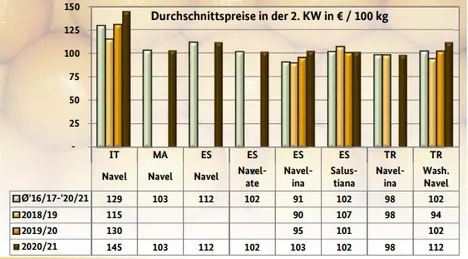Among the blond oranges, Spanish Navelina surpassed everything in terms of quantity. Navels from Italy and Spain and Salustiana from Spain supplemented the ranges. From Morocco, there were Salustiana and Navel. The first navelate from Spain arrived at an unusually early time of the season. Snowfall and low temperatures improved housing conditions. Price increases were observed on various occasions: In Munich, for example, prices for Turkish Washington navel rose. Due to the bad weather in the Spanish growing regions, generally higher incoming demands are expected from the 3rd week.
Regarding blood oranges, here Italian Moro dominated the markets, more so than Tarocco and Spanish Cara Cara. Turkish Washington Sanguine were very popular in Berlin. Demand, which was not particularly strong, was satisfied without effort. As a result of too abundant supply, prices varied in Hamburg. Otherwise, prices mostly stayed at their previous level.

Apples
A wide range was available, in which domestic offers continued to form the basis: Elstar, Jonagold, Jonagored and Boskoop were predominant. Italian fruit lost some of its market presence and French fruit was no longer as relevant as before.
Pears
Marketing was unexciting. There was no significant change in availability. Demand was met without any problems.
Table grapes
Imports from Peru, South Africa and Namibia were all available, with South African shipments being rare in some places.
Small citrus
In the case of mandarins, priority was given to Spanish Nadorcott and Clemenvilla. The organoleptic characteristics of Israeli Orri had improved and were very appealing.
Lemons
The presence of Spanish primofiori expanded: In some places, these were the only ones around. Shipments from Turkey followed most closely in terms of importance.
Bananas
Sales figures continued to oscillate at a low level. There was a lack of continuous outflow of goods into school and day-care catering.
Cauliflower
Prices trended upward. This was due to the immensely limited supplies from France, which in some cases only had supplementary status. In others, these disappeared from the range completely.
Lettuce
Iceberg lettuce generally came from Spain. An onset of winter in the growing regions led to a restriction in availability. Distributors took this as an opportunity to increase their prices.
Cucumbers
Harvest conditions deteriorated due to the frosty weather. Thus, the supply limited, which was reflected by the demand, that climbed strongly.
Tomatoes
A wide assortment was available, although overall availability was limited. In general, Demand was satisfied without effort. Nevertheless, prices often showed an upward trend.
Sweet peppers
Spanish deliveries dominated the scene. Demand was rather weak and was easily satisfied. Prices of red, yellow and green items generally converged.
Source: BLE
